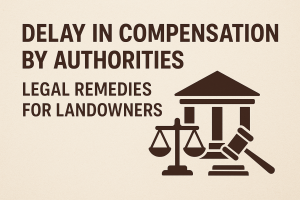In India, the domains of Revenue Law and Environmental & Forest Legislation have traditionally been seen as separate legal frameworks—one dealing with administrative control over land and taxation, the other with ecological protection and sustainable development. However, in practice, these two areas of law intersect more frequently and significantly than one might expect.
1. The Role of Revenue Records in Forest and Environmental Disputes
Revenue records such as Jamabandi, Khasra, Khatauni, and mutation entries play a critical role in determining ownership, possession, and classification of land. In forest-related cases, these documents become the basis for:
- Identifying whether a parcel of land is classified as forest land, government land, or private land.
- Determining encroachments on reserved forests or protected ecological zones.
- Challenging or upholding claims of tribal or forest-dwelling communities under the Forest Rights Act, 2006.
Often, land that appears as “gair mumkin jungle” (non-cultivable forest) in revenue records becomes the subject of dispute when used for industrial or agricultural purposes, leading to litigation under forest and environmental statutes.
2. Forest Conservation Act & Revenue Department Interface
The Forest (Conservation) Act, 1980 restricts the use of forest land for non-forest purposes without prior approval from the Central Government. However, the implementation and enforcement of this act often depend heavily on state revenue departments, which control land records and issue permissions at the district and tehsil levels.
Revenue officers, such as Tehsildars and Collectors, often:
- Act as nodal officers for processing land conversion cases.
- Play a vital role in demarcation and settlement proceedings.
- Are responsible for identifying and evicting encroachments on forest land.
Their decisions directly impact environmental clearances and legal scrutiny under forest law.
3. Legal Conflicts and Overlaps
This intersection gives rise to complex legal conflicts, such as:
- Land diverted for mining or industry under revenue permissions, later challenged under environmental law.
- Illegal mutation of forest lands into revenue records as private or agricultural land.
- Environmental Impact Assessment (EIA) processes being stalled due to unclear land ownership or classification in revenue records.
Judicial intervention has played a key role in clarifying these overlaps. The Supreme Court in T.N. Godavarman Thirumulpad v. Union of India (1997) expanded the definition of forest beyond government notification, relying in part on revenue records to identify forest land—regardless of its ownership.
4. Legal Reforms and Recommendations
With growing concerns over deforestation, biodiversity loss, and climate change, it’s essential to align revenue administration with environmental goals. Reforms may include:
- Integrated land databases combining revenue and forest records.
- Training revenue officials in environmental laws and ecological assessments.
- Clear legal guidelines for land conversion, especially in ecologically sensitive zones.
- Use of satellite imagery and GIS for transparent land classification.
5. Conclusion
The intersection of revenue law and environmental/forest legislation reflects the evolving needs of India’s legal and administrative landscape. For sustainable development to become a reality, seamless coordination between revenue authorities, forest departments, and environmental regulators is essential.
At Narendra Madhu Associates, we provide expert legal assistance in navigating these complex areas—whether you are a private landholder, industrial entity, or a community asserting your rights under environmental and forest statutes.
📞 Contact us for land classification disputes, mutation errors, forest encroachment matters, and related litigation support.
#RevenueLaw #EnvironmentalLaw #ForestRights #LandDisputes #NarendraMadhuAssociates #LegalBlog #SustainableDevelopment #ForestConservation #IndiaLaw



